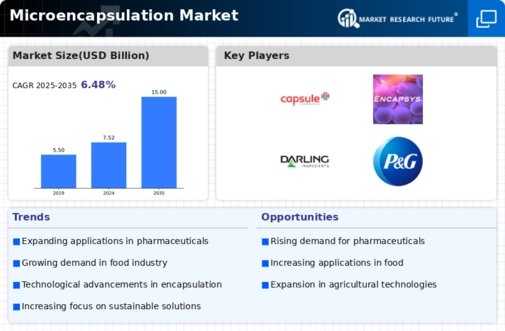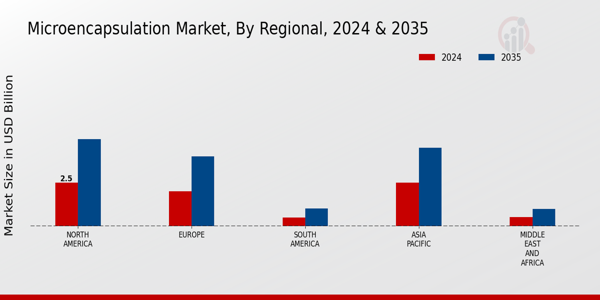Micro Encapsulation Size
Micro Encapsulation Market Growth Projections and Opportunities
The Micro-Encapsulation Market is influenced by a myriad of factors that contribute to its growth and versatility across various industries. One primary driver is the increasing demand for functional and value-added ingredients in food, pharmaceuticals, and cosmetics. Micro-encapsulation, a technology that involves enclosing active substances in microscopic particles, enhances the stability, shelf life, and controlled release of these substances. As consumers prioritize convenience and seek products with improved performance, the versatility of micro-encapsulation has led to its widespread adoption in different applications.
Geographical factors play a role in shaping the Micro-Encapsulation Market, with variations in regional preferences and regulations impacting its diverse applications. Different regions may prioritize specific industries, such as food or pharmaceuticals, influencing the demand for micro-encapsulation technologies tailored to each sector. Access to raw materials and manufacturing capabilities also varies across regions, influencing the market dynamics of micro-encapsulation on a global scale.
The Micro-Encapsulation Market is poised to attain a size of USD 19.1 billion by 2030, with a projected Compound Annual Growth Rate (CAGR) of 4.72% from 2023 to 2030. This reflects a steady growth trajectory, highlighting sustained market expansion and increasing adoption of micro-encapsulation technologies.
Market dynamics respond to the growing trend of personalized and targeted delivery systems in various industries. Micro-encapsulation allows for the controlled release of active ingredients, ensuring optimal efficacy and minimizing side effects. In pharmaceuticals, for example, micro-encapsulation facilitates the targeted delivery of drugs, enhancing patient outcomes and treatment adherence. This precision in delivery systems is a crucial factor in driving the adoption of micro-encapsulation technologies.
Economic factors, such as research and development investments and production costs, impact the Micro-Encapsulation Market. Advancements in micro-encapsulation technologies require significant investments in research and development to create innovative solutions. Economic stability and fluctuations can influence the willingness of industries to invest in these technologies, impacting the overall market growth. Producers must balance the costs of implementing micro-encapsulation with the potential benefits it offers across different applications.
Regulatory factors are pivotal in shaping the Micro-Encapsulation Market. Compliance with safety standards, labeling regulations, and quality controls is essential for market credibility. Micro-encapsulation involves the use of various materials, and adherence to regulatory frameworks ensures the safety and efficacy of the encapsulated products. Regulatory compliance also plays a role in gaining consumer trust, particularly in industries like food and pharmaceuticals.
Technological advancements and ongoing research contribute to the dynamic nature of the Micro-Encapsulation Market. Innovations in encapsulation materials, techniques, and applications continually expand the possibilities for micro-encapsulation across industries. The development of environmentally friendly encapsulation materials and sustainable practices also aligns with the broader trend of responsible and eco-friendly manufacturing.









Leave a Comment